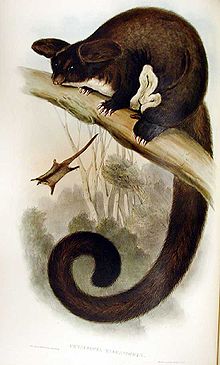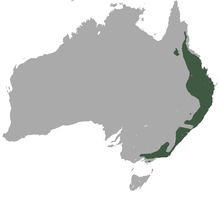Greater gliders
| Greater glider | |
|---|---|
 |
|
| Scientific classification | |
| Kingdom: | Animalia |
| Phylum: | Chordata |
| Class: | Mammalia |
| Infraclass: | Marsupialia |
| Order: | Diprotodontia |
| Family: | Pseudocheiridae |
| Subfamily: | Hemibelideinae |
| Genus: |
Petauroides Thomas, 1888 |
| Species: | P. volans |
| Binomial name | |
|
Petauroides volans (Kerr, 1792) |
|
 |
|
| Greater glider range | |
| Synonyms | |
|
Schoinobates volans |
|
Schoinobates volans
The greater glider (Petauroides volans) is a small gliding marsupial found in Australia. It is not closely related to the Petaurus group of gliding marsupials but instead to the lemur-like ringtail possum (Hemibelideus lemuroides), with which it shares the subfamily Hemibelideinae.
The greater glider is nocturnal and is a solitary herbivore feeding almost exclusively on Eucalyptus leaves and buds. Like its relative the lemur-like ringtail, the greater glider is found in two forms: a sooty brown form, or a grey-to-white form.
The greater glider is found in eucalypt forest from Mossman, Queensland, to Daylesford, Victoria.
Greater gliders have a head and body about 39 to 43 centimetres (15 to 17 in) long, with the females being generally larger than the males. Their body is covered with a shaggy coat of fur that increases their apparent size, and the tail is long and bushy, ranging from 44 to 53 centimetres (17 to 21 in). The head is short, but with a pointed muzzle, and large ears fringed and backed with long fur. Each side of the body bears membranes stretching between the elbow and the ankle, that give the animal the ability to perform controlled glides. This is in contrast to other gliding marsupials (such as the sugar glider) that have gliding membranes stretching from the wrists to the ankles.
The feet have strongly recurved claws to grip onto bark or other surfaces. There are five toes on each foot, with the first toe on the hind foot, and the first two toes on the fore foot, being opposable.
The fur is soft and up to 60 millimetres (2.4 in) long; the colour is variable within the same populations, ranging from white to brown and charcoal. Body mass varies clinally from about 1,600 grams (3.5 lb) in southern Victoria to about 600 grams (1.3 lb) in north Queensland.
...
Wikipedia

